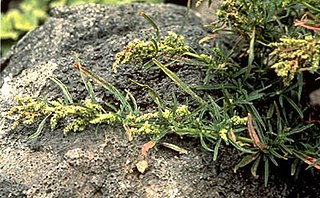
Amaranthus brownii was an annual herb in the family Amaranthaceae. The plant was found only on the small island of Nihoa in the Northwestern Hawaiian Islands, growing on rocky outcrops at altitudes of 120–215 m (394–705 ft). It was one of nine species of Amaranthus in the Hawaiian Islands, as well as the only endemic Hawaiian species of the genus. It is now considered extinct.

Canavalia molokaiensis, commonly known as the Molokaʻi Jack-bean or puakauhi, is a rare species flowering plant in the legume family, Fabaceae, that is endemic to the island of Molokaʻi in Hawaii. This and other Hawaiian Canavalia are known there as ʻāwikiwiki.
Hibiscadelphus woodii, or Wood's hau kuahiwi, is a species of flowering plant in the family Malvaceae endemic to Kauai, Hawaii.
Kokia kauaiensis, the Kauai treecotton or Kauaʻi Kokiʻo, is a species of flowering plant in the mallow family, Malvaceae, that is endemic to Kauaʻi, Hawaii.
Scheidea lychnoides is a species of plant in the family Caryophyllaceae. It is endemic to dry forests and low shrublands in Hawaiʻi. It is threatened by habitat loss.
Schiedea viscosa, also called climbing alsinidendron, is a species of flowering plant in the family Caryophyllaceae. It is endemic to lowland and montane moist forests on Kauai in the Hawaiian Islands. It is threatened by habitat loss.

Centranthus trinervis is a species of plant in the family Caprifoliaceae. It is endemic to Corsica, France where there is a single sub-population of which the only 140 of the individual plants remain. The common name of the plant is Centranthe À Trois Nervures in French. Its natural habitat is Mediterranean-type shrubby vegetation. It is currently threatened by habitat loss.

Schiedea adamantis, commonly known as Diamond Head schiedea, is a species of flowering plant in the family Caryophyllaceae, that is endemic to the island of Oʻahu in Hawaii. It inhabits low shrublands on steep slopes along the northwest rim of Diamond Head Crater. Associated plants include nehe, kāwelu, ʻakoko, and ʻilima. There are only about 30 individuals remaining, and they are threatened by habitat loss.

Schiedea is a genus of flowering plants in the family Caryophyllaceae. It contains 35 species which are endemic to Hawaii.

Schiedea kaalae, known as Oahu schiedea or Maʻoliʻoli in Hawaiian, is a species of flowering plant in the family Caryophyllaceae, that is endemic to the island of Oʻahu in Hawaii. It inhabits coastal mesic and mixed mesic forests at elevations of 210–790 m (690–2,590 ft) in the Koʻolau and Waiʻanae Ranges. It is threatened by habitat loss.

The Peltigeraceae are a family of lichens in the order Peltigerales. The Peltigeraceae, which contains 15 genera and about 600 species, has recently (2018) been emended to include the families Lobariaceae and Nephromataceae. Many Peltigeraceae species have large and conspicuous, leathery thalli. They largely occur in cool-temperate to tropical montane climates. Tripartite thalli involving fungus, green algae and cyanobacteria are common in this family.
Schiedea helleri is a rare species of flowering plant in the family Caryophyllaceae known by the common names Heller's schiedea and Kaholuamanu schiedea. It is endemic to Hawaii, where it is known only from the island of Kauai. It is threatened by the degradation of its habitat. It was federally listed as an endangered species of the United States in 1996.

Schiedea hookeri is a rare species of flowering plant in the family Caryophyllaceae known by the common names Hooker's schiedea and sprawling schiedea. It is endemic to Hawaii, where it is known only from the island of Oahu. It is thought to have been extirpated from Haleakalā on Maui. It is threatened by the degradation and destruction of its habitat. It was federally listed as an endangered species of the United States in 1996.
Schiedea kealiae is a rare species of flowering plant in the family Caryophyllaceae known by the common name Waianae Range schiedea. It is endemic to Hawaii, where it is known only from the Waianae Range on the island of Oahu. It is threatened by the degradation and destruction of its habitat. It was federally listed as an endangered species of the United States in 1996.
Schiedea sarmentosa is a rare species of flowering plant in the family Caryophyllaceae known by the common name cliff schiedea. It is endemic to Hawaii, where it is known only from the island of Molokai. It is threatened by the degradation and destruction of its habitat. It is a federally listed endangered species of the United States.

Scepocarpus trinervis (Hochst.) Friis & Immelman is a softly woody dioecious liane, sometimes epiphytic, climbing to 20 m, often to the canopy and hanging in festoons. It is one of some 44 species of Urera belonging to the nettle family Urticaceae. It is known in English as the tree climbing-nettle or climbing nettle.

Persoonia trinervis is a species of flowering plant in the family Proteaceae and is endemic to the south-west of Western Australia. It is an erect, sometimes spreading shrub with densely hairy young branchlets, spatula-shaped or lance-shaped leaves with the narrower end towards the base, and densely hairy yellow flowers.
Tainia trinervis, commonly known as the ribbon orchid, is an evergreen, terrestrial plant with crowded pseudobulbs, each with a single smooth, shiny leaf and up to fourteen greenish to yellowish flowers with red or purplish stripes in the middle. It is found in tropical Southeast Asia, New Guinea and northern Australia.

Pultenaea trinervis, commonly known as three-nerved bush-pea, is a species of flowering plant in the family Fabaceae and is endemic to the south-east of South Australia. It is a low, prostrate to erect shrub with hairy, elliptic to lance-shaped leaves and yellow to orange and red, pea-like flowers.












